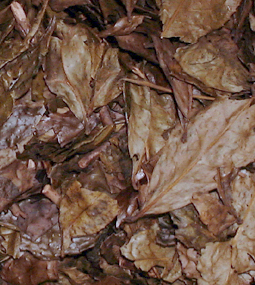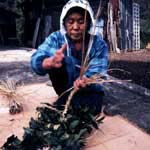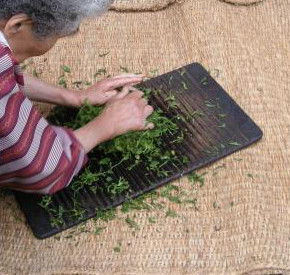 Kageboshi bancha (陰干し番茶), also known as hikage bancha (日陰番茶)is a shade-dried bancha.
Kageboshi bancha (陰干し番茶), also known as hikage bancha (日陰番茶)is a shade-dried bancha.
Unlike some of the sun-dried bancha teas like kyobancha, kageboshi bancha is very hard to find on the market, and is produced at a small scale.
This is a tea made in a very traditional way. People will often make it for their own consumption, and is considered to be a low-grade tea.
How is kageboshi bancha made?
As far as I know, kageboshi bancha is produced in the prefectures of Fukui, Shimane, and Gifu. As its name implies, this tea isn’t dried in direct sunlight. Indoor drying is also considered to be shade-drying.
 The kageboshi bancha made in Shimane is called daitou bancha (大東番茶), and in Gifu it’s gujou bancha (郡上番茶).
The kageboshi bancha made in Shimane is called daitou bancha (大東番茶), and in Gifu it’s gujou bancha (郡上番茶).
In Katsuyama city, Fukui prefecture, the traditional way to make kageboshi bancha is to cut branches with bancha leaves and then bind them with a rope. Next, they are left to dry by hanging them from the eaves. Note that they aren’t steamed nor roasted!
 Gujou bancha is primarily made in Shirotori town. It’s made from yamacha leaves which are lightly steamed, about 10 seconds.
Gujou bancha is primarily made in Shirotori town. It’s made from yamacha leaves which are lightly steamed, about 10 seconds.
Then the leaves are rolled in a mat and left to dry in the shade for 4 or 5 days.
Brewing kageboshi bancha
I haven’t tried kageboshi bancha yet, and unfortunately I didn’t find any information online regarding brewing instructions.
However, I’m sure it involves using a lot of water and temperature because it’s similar to kancha. That means you must boil the leaves for a rather long time.
I promise that when I go to Japan again, I’ll update the information 🙂
